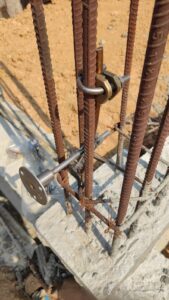

In the world of electrical safety, earthing or grounding is a critical safety measure that protects both people and equipment. In this blog, you will understand the concept of “Structural Earthing,” a standard construction practice that offers numerous benefits. We’ll also compare it with “Conventional Earthing” another essential method in the field.


A metallic structure which has the current-carrying capability is likely to be hit by lightning or a fault current due to a fault occurring in the equipment attached to the structure. Hence the structure needs to be protected. The structure is required to have a low-impedance path to the grounding system to transfer the fault current safely into the ground within a second.
Structural Earthing is a technique that involves the use of a building’s natural components, such as metal reinforcements in ceilings, walls, and facades, to create a large-volume shield or a Faraday cage. This shield provides a path for lightning or fault currents, dispersing them through numerous parallel paths. This dispersion reduces the voltage drop due to the lightning current, ensuring the safety of the structure and its occupants.
Structural Earthing is primarily used for non-electrical equipment. It offers several advantages, including increased safety for humans during lightning strikes, protection for electrical installations during faults, and shielding for electronic systems against Electro Magnetic Pulse (EMP). Moreover, Structural Earthing systems are resistant to corrosion, require less maintenance, and are economical in the long run.
Conventional Earthing, on the other hand, is an independent system where a dedicated earthing conductor is connected directly between the electrical equipment or the metallic structure to the earth pit or a network of earth pits. The size of the earthing conductor depends on the magnitude of the fault current. This method is primarily used for electrical equipment.
The main purpose of Earthing or Grounding is to provide a reliable return path for any fault current that may be developed during a short circuit between phases or phase to ground. Please refer to the below figure, in which the electrical power is generated by the Generator.
Let’s assume there is a fault within the motor i.e phase to phase or 3-phase fault. In such a case, the fault current is returned to its source and not to ground if the system is not grounded. Under normal circumstances, a fault at the motor should cause sufficient current to flow for operating the protective devices. Devices such as circuit breakers or fuses are located in the distribution system in a short time based on the characteristics curves and settings provided (in the case of Circuit Breakers) to trip and isolate the fault.
Hence the earth’s return path (shown in blue colour cable in the above diagram) has to be grounded through cable/conductors at least two points (for redundancy) to the earth grid in which the earth pits are connected. This is the conventional way of earthing the electrical system.
Structural earthing is the method by which the nearby conducting materials are interconnected together. Please refer to the below figure.
Structural earthing provides a path for structural currents and ensures that the interconnected equipment is at the same potential. The above figure shows that the equipment such as Generator, Power Distribution Board and Generator bodies are connected to the structure (metallic skid) and hence no potential difference exists that threatens personnel safety. The equipment earthing is effectively in parallel with the human and the fault current is divided between them.
Structural Earthing and Conventional Earthing are required to be used based on the application and the magnitude of the fault current.
Please refer to the figure. When both conventional earthing and structural are complete for the above-considered example, then they will add value to one another.
The Structural Earthing provides an alternative return path, and the earthing conductor duplicates the function of the structural earthing.
Surge Protection Devices (SPD)
Lightning Protection Zones and their Application to SPD Selection
How does a Lightning Arrester work?
Thank you for reading the blog, Axis is a leading manufacturer and supplier of Electrical Components to over 80+ Countries. Talk to our industry expert by visiting our contact us section. You can also watch our videos by our experts – click here.
Earth resistance is the measure of how easily electric current can flow from an electrode…
Lightning arrester rods, surge arresters, or lightning conductors are metal rods installed on a building…
Follow us on LinkedIn for the latest updates The protective angle method is one of…
In this trending era of technology and development, earthing in substations plays a vital role.…
The electrically conductive connection between the air-termination system and the earth-termination system is the down…
In this blog, we're focusing on the essential differences between Galvanised Iron Pipe Earthing, also…